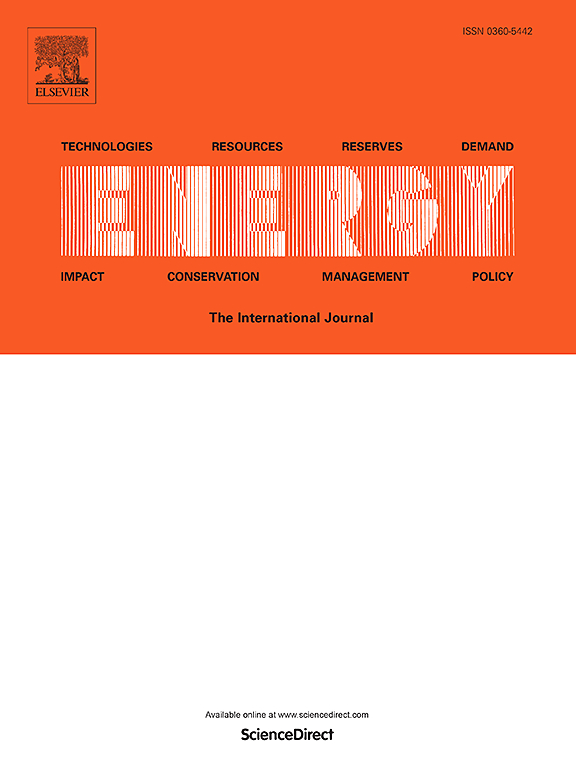Thermodynamic investigation of an efficient combined power and refrigeration cycle designed for providing variable energy output
IF 9
1区 工程技术
Q1 ENERGY & FUELS
引用次数: 0
Abstract
To efficiently recover waste flue gas heat and meet various demands for electricity and cooling, this paper proposes a novel ammonia-water combined power and refrigeration cycle enabling flexible energy output adjustment. The adjustment of energy output is achieved by expanding a portion of ammonia-rich vapor, which is destined for refrigerant production, in a low-pressure turbine. Thermodynamic analysis results demonstrate that the cycle can efficiently reclaim the waste gas heat across a wide range of temperature grades, while offering high flexibility in energy output adjustment. Under the heat source condition of 300 °C/10 kg s−1, the adjustable ranges for the refrigeration capacity and net power are 0–538.2 kW and 348.9–440.4 kW, respectively, while consistently maintaining a sufficient recovery of the heat source (exhaust temperature at around 109 °C). When the cycle achieves the maximum refrigeration capacity and net power, the corresponding effective exergy efficiencies are 0.4119 and 0.3801, respectively. The results also reveal that as the energy output is regulated arbitrarily, the high-pressure turbine sustains a near-constant base power load (361.7–364.7 kW), and only the exergy destruction occur in components associated with refrigeration and low-pressure turbine significantly changes. Furthermore, when compared to two other combined power/cooling cycles in literature and the triple-pressure Kalina cycle, the proposed cycle can achieve 94.15 %, 44.45 % and 10.36 % relatively higher effective exergy efficiency, respectively.
为提供可变能量输出而设计的高效联合动力和制冷循环的热力学研究
为有效回收烟气余热,满足电力和制冷的各种需求,本文提出了一种能灵活调节能量输出的新型氨-水联合发电制冷循环。能量输出的调整是通过在低压涡轮机中扩大一部分用于制冷剂生产的富氨蒸汽来实现的。热力学分析结果表明,该循环可以在很大的温度等级范围内有效地回收废气热量,同时在能量输出调节方面具有很高的灵活性。在300℃/10 kg s−1热源工况下,制冷量和净功率的可调范围分别为0 ~ 538.2 kW和348.9 ~ 440.4 kW,同时保持热源的充分回收(排气温度在109℃左右)。当循环达到最大制冷量和净功率时,对应的有效火用效率分别为0.4119和0.3801。结果还表明,在能量输出任意调节的情况下,高压涡轮基本功率负荷(361.7 ~ 364.7 kW)接近恒定,只有制冷和低压涡轮相关部件的火用破坏发生显著变化。此外,与文献中其他两种动力/冷却联合循环和三压Kalina循环相比,该循环的有效火用效率分别提高了94.15%、44.45%和10.36%。
本文章由计算机程序翻译,如有差异,请以英文原文为准。
求助全文
约1分钟内获得全文
求助全文
来源期刊

Energy
工程技术-能源与燃料
CiteScore
15.30
自引率
14.40%
发文量
0
审稿时长
14.2 weeks
期刊介绍:
Energy is a multidisciplinary, international journal that publishes research and analysis in the field of energy engineering. Our aim is to become a leading peer-reviewed platform and a trusted source of information for energy-related topics.
The journal covers a range of areas including mechanical engineering, thermal sciences, and energy analysis. We are particularly interested in research on energy modelling, prediction, integrated energy systems, planning, and management.
Additionally, we welcome papers on energy conservation, efficiency, biomass and bioenergy, renewable energy, electricity supply and demand, energy storage, buildings, and economic and policy issues. These topics should align with our broader multidisciplinary focus.
 求助内容:
求助内容: 应助结果提醒方式:
应助结果提醒方式:


